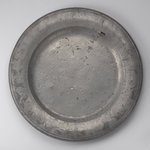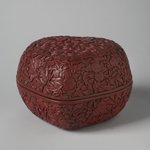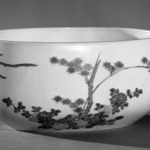
Illustration from a Manuscript of the Bihari Satasai
Asian Art
MEDIUM
Opaque watercolor and gold on paper
DATES
early 18th century
DIMENSIONS
with frame: 16 x 13 1/2 x 1/2 in. (40.6 x 34.3 x 1.3 cm)
image: 9 13/16 x 7 11/16 in. (25 x 19.6 cm) (show scale)



INSCRIPTIONS
The inscription at the top can be transliterated as follows:
Avata jata na janiye, tejahim taji siyarana / gharahim jamval laum ghatyau, kharo dinamana / 612
The translation of this verse is:
As the short days of the Pus month denuded of warmth and hardly noticed
Is the welcome made to the man who stays with his in-laws.
Translation by Krishna P. Bahadur in Bihari: The Satasai (London: Penguin Books, 1990). In this translation the verse is listed as 702, p. 307. Bahadur comments on the verse, noting that Pus is the winter month, corresponding to December-January, when the days are shortest. The verse refers to the frosty reception a husband receives at the home of his wife's parents, and the brevity of the ideal visit to one's in-laws, but Bahadur notes that commentators have interpreted the verse with a more romantic meaning: "A woman can't show indifference and keep away from her lover for long in the winter month of Pus. Her indifference is as shortlived as the welcome a man gets when he stays too long with his in-laws." (Bahadur p. 396, translating Dr. Desarajasingha Bhati's Hindi commentary to the Bihari Bhasya 1978).
COLLECTIONS
Asian Art
ACCESSION NUMBER
2010.48.19
CREDIT LINE
Bequest of Dr. Bertram H. Schaffner
CATALOGUE DESCRIPTION
Page from an illustrated manuscript of the Satasai (700 Verses), a romantic/devotional poem written in Braj Bhasa (a regional variant of Hindi) by Bihari in the early 17th century.
The image is divided into four quadrants defined by architecture. In the upper left quarter, the romantic heroine -- dressed in a red blouse and golden skirt -- sits talking with her confidante (sakhi). In the upper right quarter, a standing man appears twice, once speaking with a seated woman -- not the heroine or her friend -- and once facing away from her. In the lower left quarter, two women speak with each other outside -- neither appears to be the sakhi -- and in the lower right quarter, the heroine appears again seated with her confidante, this time in a dejected posture with the sakhi gesturing as if making an important point.
Scenes like that in the lower right are a common feature of the Satasai, in which the romantic heroine suffers terribly when she does not see her beloved and must be comforted by her friend. Often the heroine initiates the separation, which is her way of punishing her lover for infidelity. The confidante scolds and cajoles her, encouraging her to swallow her pride and end her suffering.
The text at the top of the page is a verse from the Satasai. Its relationship to the image below is not immediately evident, because it deals with the cold reception a man receives at the home of his inlaws. However, traditional commentators on the verse have related it to a woman's inability to withhold her love from her husband, noting that she can bear the separation for about the same period that he can bear a visit to his in-laws. If we follow this interpretation of the verse, then we might see the lower right quadrant as an image of the suffering woman and the upper right quadrant as her mate, first speaking with his mother-in-law and then leaving.
This page may be from a dated manuscript of the Satasai, made in Mewar in 1719. However, many pages associated with that manuscript are in a slightly different style. It is likely that the prolific atelier of Mewar produced many copies of the Satasai and that this is from a different series.
MUSEUM LOCATION
This item is not on view
CAPTION
Illustration from a Manuscript of the Bihari Satasai, early 18th century. Opaque watercolor and gold on paper, with frame: 16 x 13 1/2 x 1/2 in. (40.6 x 34.3 x 1.3 cm). Brooklyn Museum, Bequest of Dr. Bertram H. Schaffner, 2010.48.19 (Photo: Brooklyn Museum, 2010.48.19_PS4.jpg)
IMAGE
overall, 2010.48.19_PS4.jpg. Brooklyn Museum photograph, 2012
"CUR" at the beginning of an image file name means that the image was created by a curatorial staff member. These study images may be digital point-and-shoot photographs, when we don\'t yet have high-quality studio photography, or they may be scans of older negatives, slides, or photographic prints, providing historical documentation of the object.
RIGHTS STATEMENT
No known copyright restrictions
This work may be in the public domain in the United States. Works created by United States and non-United States nationals published prior to 1923 are in the public domain, subject to the terms of any applicable treaty or agreement.
You may download and use Brooklyn Museum images of this work. Please include caption information from this page and credit the Brooklyn Museum. If you need a high resolution file, please fill out our online application form (charges apply).
The Museum does not warrant that the use of this work will not infringe on the rights of third parties, such as artists or artists' heirs holding the rights to the work. It is your responsibility to determine and satisfy copyright or other use restrictions before copying, transmitting, or making other use of protected items beyond that allowed by "fair use," as such term is understood under the United States Copyright Act.
The Brooklyn Museum makes no representations or warranties with respect to the application or terms of any international agreement governing copyright protection in the United States for works created by foreign nationals.
For further information about copyright, we recommend resources at the United States Library of Congress, Cornell University, Copyright and Cultural Institutions: Guidelines for U.S. Libraries, Archives, and Museums, and Copyright Watch.
For more information about the Museum's rights project, including how rights types are assigned, please see our blog posts on copyright.
If you have any information regarding this work and rights to it, please contact copyright@brooklynmuseum.org.
RECORD COMPLETENESS
Not every record you will find here is complete. More information is available for some works than for others, and some entries have been updated more recently. Records are frequently reviewed and revised, and we welcome any additional information you might have.
































